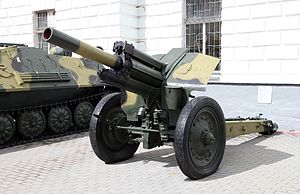122 mm howitzer M1938 (M-30)
| 122 mm howitzer M1938 (М-30) | |
|---|---|

M-30 in VDV history museum, Russia.
|
|
| Type | Field howitzer |
| Place of origin | Soviet Union |
| Production history | |
| Designer | Design bureau of Motovilikha Plants, headed by F. F. Petrov |
| Designed | 1938 |
| Manufacturer | Plants No. 92 & No. 9 |
| Produced | 1939-1955 |
| Number built | 19,266 |
| Variants | M-30S, Chinese Type 54 |
| Specifications | |
| Weight | combat: 2,450 kg (5,401 lbs) travel: 3,100 kg (6,834 lbs) |
| Length | 5.9 m (19 ft 4 in) (with limber) |
| Barrel length | bore: 2.67 m (8 ft 9 in) L/21.9 overall: 2.8 m (9 ft 2 in) L/23 (without breech block) |
| Width | 1.98 m (6 ft 6 in) |
| Height | 1.82 m (6 ft) |
| Crew | 8 |
|
|
|
| Caliber | 121.92 mm (4.8 in) |
| Breech | interrupted screw |
| Recoil | hydropneumatic |
| Carriage | split trail |
| Elevation | -3° to 63.5° |
| Traverse | 49° |
| Rate of fire | 5-6 rounds per minute |
| Maximum firing range | 11.8 km (7.33 mi) |
The 122 mm howitzer M1938 (M-30) was a Soviet 121.92 mm (4.8 inch) howitzer. The weapon was developed by the design bureau of Motovilikha Plants, headed by F. F. Petrov, in the late 1930s, and was in production from 1939 to 1955. The M-30 saw action in World War II, mainly as a divisional artillery piece of the Red Army (RKKA). Captured guns were also employed later in the conflict by the German Wehrmacht and the Finnish Army. Post World War II the M-30 saw combat in numerous conflicts of the mid- to late twentieth century in service of other countries' armies, notably in the Middle East.
In 1930 Red Army (RKKA) authorities started to look for a new divisional-level howitzer to replace the pre-World War I 122 mm howitzer M1909 and 122 mm howitzer M1910. Although both pieces were eventually modernized, resulting in the 122-mm howitzer M1909/37 and the 122-mm howitzer M1910/30 respectively, these upgrades did not address some shortcomings in the original designs.
The first attempt to develop a new howitzer was made by the KB-2 design bureau under the supervision of German engineers. The design, known as Lubok, reached trials in 1932 and in 1934 was adopted as the 122-mm howitzer model 1934. It had a 23 caliber barrel, a maximum elevation of 50°, traverse of 7°, and a combat and travelling weight of 2,250 and 2,800 kg respectively. Like its predecessors, Lubok had a fixed trail carriage and although it was equipped with suspension, its wheels lacked tires, limiting towing speed to only 10 km/h. Nevertheless, it was undoubtfully superior to the M1910/30 which remained in production until 1941. However, after eight pieces were built in 1934-1935, production was stopped for unclear reasons, possibly relating to the disbanding of KB-2.
...
Wikipedia
